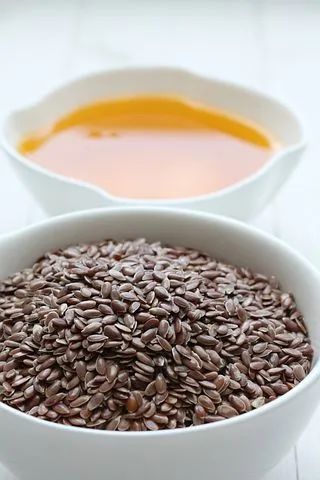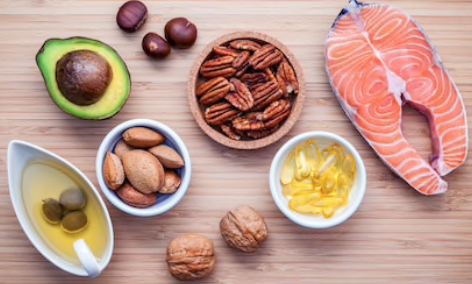I have seen some articles on the Internet teaching how to make baby food, vigorously promoting flaxseed oil and walnut oil, and boasting a lot of benefits, including promoting brain development. The conclusion is that it is very suitable for baby food supplements.
Frequently some new moms also asked me: Can flaxseed oil and walnut oil really “strengthen the brain and improve intelligence”? Some people say that children need fat, and these two oils can be converted into DHA after eating, which will make children smarter.
To be honest, every time I see such advertisements and promotions that distort scientific facts, I can’t afford to complain… These people really know nonsense.

Do you need to add oil to baby food?
The answer is that it can be added, but should be as little as possible.
According to NHS advice, use as little cooking oil as possible when preparing food for young children. If you want to use it, it is recommended to choose an edible oil rich in mono- or polyunsaturated fats, such as canola, soybean, or olive oil.
It should be pointed out here that using as little cooking oil as possible does not mean that young children need a low-fat diet. For example, low-fat and skim milk are not suitable for children under the age of 2. Because fat is indeed very important for children’s brain development, it is also an important source of energy for them, and helps the body absorb fat-soluble vitamins such as vitamins A, D, E, K.
But for 1-2 year olds, fat intake is not needed and should not depend on cooking oil. Whole-fat foods (such as whole milk, yogurt, cheese) and low-mercury deep-sea fish (oily fish) are important sources of fat for them.

Deep sea fish (oily fish) is important in large part because it is rich in omega-3 polyunsaturated fatty acids, especially DHA (docosahexaenoic acid) and EPA (eicosapentaenoic acid).
Medical research over the past few decades has found that DHA and EPA have several health benefits for the human body. They help keep the body’s cell membranes elastic, help cells function properly, and block some inflammation-causing compounds from working, helping to reduce the risk of cardiovascular disease, and may help maintain brain health, improve depression, and reduce inflammation development of diseases such as inflammatory bowel disease and asthma.
In addition, studies have also found that DHA is very important for the development of fetal and infant brain, retina, and neuronal cells. During the third trimester, the head of the fetus develops and grows rapidly. At 40 weeks gestation, the fetal brain can nearly triple its weight at the end of the second trimester. Omega-3 fatty acids, especially DHA, are important structural fatty acids for the brain and eyes, so pregnant women need to consume enough DHA to ensure the healthy development of the fetus.

After babies are born, DHA continues to build up in their brains until they are 2 years old. For example, breastfed babies can basically get at least 60 mg of DHA from their breast milk every day, and accumulate 10 mg in their bodies. By 6 months after birth, their brain DHA concentration can be increased by about 39% compared to birth.
However, there is currently insufficient evidence that increasing DHA intake (such as adding DHA to formula milk or taking DHA supplements directly) leads to clear health benefits (including physical growth and intellectual development) in children. Still, given the importance of DHA in brain and visual development, some dietary intake is recommended.
Perhaps it is precisely because of this that a large wave of market promotions is desperately boasting about DHA. So the question is, can flaxseed oil and walnut oil provide the body with DHA?
Yes, but very, very limited.

Both flaxseed oil and walnut oil are rich in alpha-linolenic acid (ALA), another type of omega-3 fatty acid. Our current understanding of alpha-linolenic acid is not as good as that of DHA and EPA. Existing research shows that alpha-linolenic acid also has the effect of reducing inflammatory mediators in the body, so it may also help reduce the risk of some chronic diseases. Since the human body cannot synthesize alpha-linolenic acid by itself, it must be obtained from food, so linseed oil and walnut oil rich in alpha-linolenic acid are indeed good edible oil choices. But they have a lower smoke point, making them less suitable for stir-frying and more suitable for things like salads and dips.
Most of the walnut oil contains polyunsaturated fatty acids, and only a small amount of saturated fatty acids (9%). Saturated fatty acids are the “bad” fats we need to limit, so walnut oil is still a very healthy oil on its own. However, unrefined walnut oil has a low smoke point and can only be used for dressing, not heating. After refining, the smoke point is similar to that of refined rapeseed oil, and it can be used for cooking. However, the cost is much higher than the refined rapeseed oil. It contains only 7% fatty acid. At the same time, rapeseed oil also contains alpha-linolenic acid.
Theoretically, α-linolenic acid can indeed be converted into DHA and EPA through biochemical reactions under the action of some enzymes. However, many advertisements and salesmen exaggerate its conversion ability in the human body, misleading consumers to believe that by ingesting flaxseed oil and walnut oil, the alpha-linolenic acid can be fully converted into DHA and EPA in the body, Thereby bringing the health benefits of DHA and EPA to the body.
In fact, our body converts alpha-linolenic acid into DHA and EPA very inefficiently, and most of the alpha-linolenic acid is metabolized in the form of energy in the body. One study shows that only 2% to 10% of alpha-linolenic acid can be converted into DHA or EPA in the body; many other studies believe that the conversion rate is lower: for example, Goyens et al. Linolenic acid is converted to EPA, but only 0.013% is converted to DHA; the study by Hussein et al. found that the efficiency of α-linolenic acid converted to DHA and EPA in humans is extremely low, <0.01% and 0.3%, respectively.
The conversion efficiency is low, and young children are not encouraged to consume too much edible oil, so if you want to rely on oil, whether it is flaxseed oil or walnut oil to supplement DHA for children, the effect is basically negligible.
Do children need DHA supplements?
What is the most reasonable way to get it?

Babies 0-6 months should be fed either breast milk or formula.
Therefore, it is generally not necessary to consider supplementing the baby with additional DHA.
If breastfeeding, it is best for mothers to eat low-mercury, omega-3-rich fish 2-3 times a week (about 230-340 grams in total), so the baby can get enough DHA from breast milk. Moms who eat little or no fish can also consider taking DHA supplements, 200-300 mg per day.
For babies who are fed with formula, most of the formula sold on the market now has added DHA, and parents can pay attention to the nutrition label when purchasing.
After 6 months, the baby begins to introduce solid food.
Like most other nutrients,
Starting with a diet is far more reliable than taking nutritional supplements.
You can properly feed your baby after 6 months some fish, and it is best to have a richer variety. But try to avoid seafood that is high in mercury for children, such as grouper, flounder, shark, tilefish, swordfish, carp, freshwater bass, American lobster, etc. Better choices are salmon, sardines, herring, anchovies, mussels, etc. What I want to emphasize is that even if you choose fish with lower mercury content, it is best not to take only one type of food, but try to take more variety to reduce potential risks.
This chart can help you choose which fish to eat, and how often to eat them, based on their mercury levels.

- The FDA recommends that children eat fish 1-2 times a week, depending on the child’s age and total energy needs:
On average, a serving is about:
- ounce at age 1 to 3
- ounces at age 4 to 7
- ounces at age 8 to 10
- ounces at age 11
- Egg yolks also contain a certain amount of DHA;
- Dried fruits such as walnuts, peanuts, pumpkin seeds, sunflower seeds, etc. are rich in alpha-linolenic acid, which can be converted into DHA in our body, but as just mentioned, the conversion efficiency is very low.
If the child is allergic to seafood, or picky eaters do not eat fish, it is difficult to get enough DHA through the diet, then consider taking DHA supplements. There are two types of DHA supplements on the market: deep-sea fish and seaweed. In view of the problem of excessive heavy metals in deep-sea fish DHA, it is recommended to choose seaweed DHA as much as possible.

It can be seen from the recommended amount of fish for children that different age groups have different needs for DHA, but there is still insufficient evidence to formulate the recommended amount of DHA for children. There are some DHA supplements on the market that are specially designed for children, but it is really hard to say how much should be supplemented…
How much DHA does a child need to take?
Based on the recommendations of various institutions, it is recommended that children from 6 months to 2 years old be supplemented with about 40-100mg DHA per day, and children over 2 years old are recommended to supplement about 55-250mg DHA per day.
WHO and FAO recommendation:

Other countries and international organizations
The recommendations vary widely from country to country. The recommended intake for 1-2 years old is 40mg-150mg; 55-250mg for over 2 years old; 200mg for over five years old.

On the other hand, supplementing with DHA is generally safe, but not more is better.
In theory, a large intake of DHA or an imbalance between the amount of DHA ingested and other fatty acids may affect the body’s metabolism of other fatty acids.
However, the European Food Safety Authority stated in a supplement report published in 2012 that the available data are insufficient to set an upper limit on the tolerable intake of omega-3 fatty acids for any population.
The panel concluded that long-term intake of a combined supplement of 5000 mg of EPA and DHA per day is unlikely to pose health risks to humans (such as causing bleeding problems or affecting immune function, glucose homeostasis or lipid peroxidation) ).
Summary
- DHA is an important structural fatty acid for the brain and eyes, and the development of infants and young children is inseparable from DHA.
- For infants and young children, the ideal sources of DHA are breast milk and low-mercury deep-sea fish.
- Flaxseed oil and walnut oil are rich in alpha-linolenic acid, one of the omega-3 fatty acids, and are a good choice for edible oils, but the conversion of alpha-linolenic acid into DHA in the human body is very inefficient. The effect of supplementing DHA is a drop in the bucket.
- If children cannot get enough DHA because of diet structure, they can supplement DHA in moderation.

